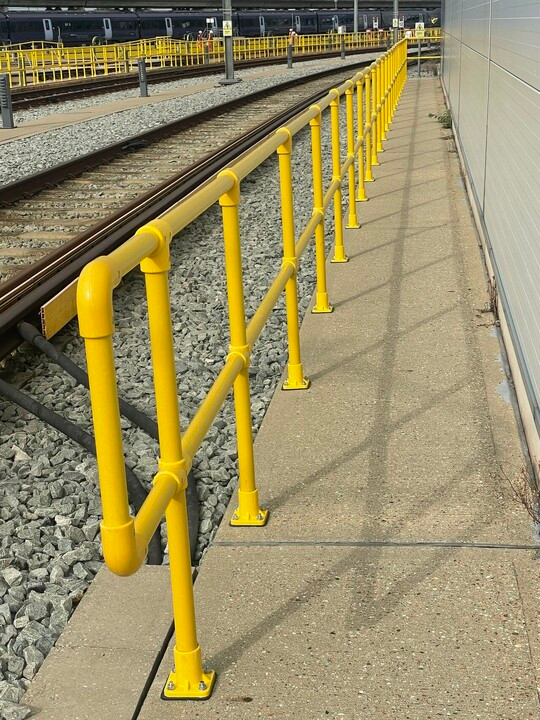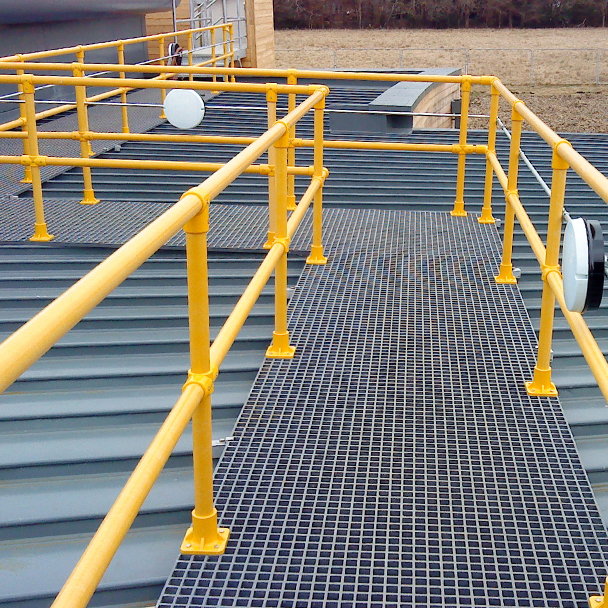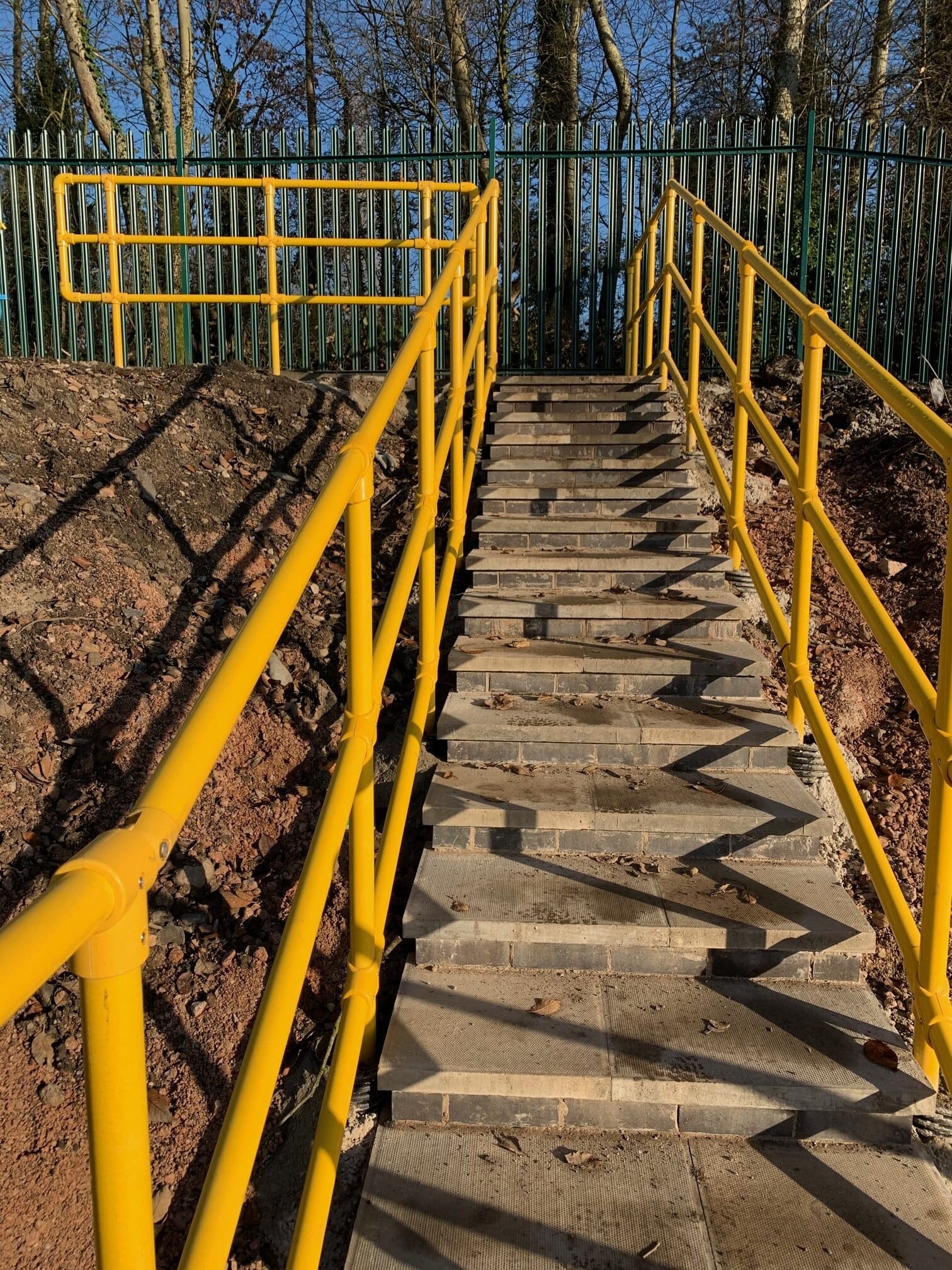Um FRP (Fiber-Reinforced Plastic) Customizable Platform is a durable, lightweight, and corrosion-resistant platform designed for a variety of industrial, commercial, and marine applications. Unlike traditional steel or wooden platforms, FRP platforms offer full customization options, allowing users to specify size, load capacity, surface texture, and other key attributes to meet specific project requirements.
Introdução ao desempenho do produto
This document provides an in-depth analysis of FRP Customizable Platforms, including their physical properties, specifications, advantages, disadvantages, and applications.
1. Physical Properties of FRP Customizable Platforms
1.1. High Strength-to-Weight Ratio
-
FRP platforms are significantly lighter than steel (up to 75% lighter), making them easy to transport and install.
-
Despite their lightweight nature, FRP platforms exhibit high mechanical strength, allowing them to support substantial loads.
1.2. Corrosion and Chemical Resistance
-
FRP materials are highly resistant to rust, moisture, and industrial chemicals, making them ideal for environments such as offshore platforms and chemical processing plants.
-
No degradation in harsh weather conditions, including UV exposure and saltwater exposure.
1.3. Electrical and Thermal Insulation
-
Non-conductive material, making it safe for use in electrical substations and other high-voltage areas.
-
Low thermal conductivity reduces heat transfer, improving safety and comfort.
1.4. Fire Resistance
-
Available with fire-retardant resin options such as phenolic or vinyl ester resins.
-
Can meet various fire safety standards with low smoke and toxic emissions.
1.5. Custom Surface Finishes
-
Anti-slip surfaces available for enhanced safety in wet and hazardous environments.
-
UV-resistant coatings can be applied for outdoor applications.
2. Specifications and Customization Options
2.1. Standard Dimensions (Customizable)
-
Grossura: Available in 25mm, 38mm, 50mm, or custom sizes.
-
Panel Sizes: Common sizes include 1m × 1m, 1.2m × 2.4m, or fully customized dimensions.
-
Load Capacities: Adjustable to support 500 – 10,000 kg/m² based on reinforcement and design.
2.2. Types of FRP Customizable Platforms
-
Open-Mesh FRP Grating Platforms – Ensures proper drainage and airflow.
-
Solid FRP Platforms – Used in clean environments such as food processing plants.
-
Modular FRP Platforms – Designed for quick assembly and expansion.
-
Heavy-Duty FRP Platforms – Engineered for extreme load-bearing applications.
2.3. Material Composition
-
Reinforcement Fibers: E-glass or S-glass fibers for standard strength, carbon fiber for extreme load-bearing needs.
-
Tipos de resina:
-
Polyester Resin – Cost-effective general-use resin.
-
Resina Vinil Ester – High chemical and temperature resistance.
-
Resina epóxi – Maximizes mechanical strength.
-
Resina Fenólica – Provides superior fire resistance and low smoke emission.
-
2.4. Mechanical Properties (Typical Values)
| Propriedade | Typical Value |
|---|---|
| Resistência à tracção | 300-800 MPa |
| Resistência à flexão | 250-700 MPa |
| Resistência à compressão | 300-850 MPa |
| Densidade | 1.7-2.2 g/cm³ |
| Modulus of Elasticity | 25-45 GPa |
3. Advantages of FRP Customizable Platforms
3.1. Tailored to Specific Needs
-
Fully customizable in size, shape, color, load capacity, and surface texture.
-
Can be designed with cutouts, railings, and drainage holes for specific applications.
3.2. High Strength and Durability
-
Lightweight yet capable of supporting heavy loads, reducing transportation and installation costs.
3.3. Corrosion Resistance for Harsh Environments
-
Withstands exposure to saltwater, industrial chemicals, and extreme temperatures.
3.4. Electrical and Magnetic Safety
-
Non-conductive and non-magnetic, ensuring safety in power plants and telecom sites.
3.5. Slip-Resistant and Safe
-
Customizable anti-slip textures available for wet or hazardous environments.
3.6. Low Maintenance and Long Lifespan
-
No painting, sealing, or chemical treatments required.
-
Does not rust, warp, or degrade like metal or wood.
3.7. Easy Installation
-
Lightweight, modular design allows for quick assembly and adjustments.
-
No welding or heavy lifting equipment required.
4. Disadvantages of FRP Customizable Platforms
4.1. Higher Initial Cost
-
Higher upfront costs compared to steel or wood, but lower maintenance costs over time make it cost-effective.
4.2. Lower Stiffness Compared to Steel
-
Requires additional supports for very high-load applications.
4.3. UV Sensitivity
-
May require UV-resistant coatings for long-term outdoor use.
4.4. Limited Heat Resistance
-
Weakens at temperatures above 200°C, whereas steel can withstand much higher temperatures.
4.5. Recycling Challenges
-
Difficult to recycle due to composite material composition.
5. Applications of FRP Customizable Platforms
5.1. Heavy-Duty Industrial Applications
-
Oil Refineries and Chemical Plants – Resistant to chemicals and corrosion.
-
Steel Mills and Foundries – Non-conductive and safe for high-heat environments.
-
Estações de Tratamento de Águas Residuais – Waterproof and long-lasting.
5.2. Marine and Offshore Structures
-
Shipyards and Docks – Corrosion-resistant in saltwater environments.
-
Offshore Oil Rigs – Durable and maintenance-free.
5.3. Public Infrastructure and Construction
-
Bridges, Walkways, and Stairs – Lightweight, durable, and slip-resistant.
-
Transit Stations – Fire-resistant and designed for heavy foot traffic.
5.4. Electrical and Telecommunications
-
Substations and Power Plants – Non-conductive for improved safety.
-
Data Centers – Provides a durable, lightweight alternative to steel flooring.
5.5. Food and Pharmaceutical Industries
-
Cleanrooms and Processing Plants – Easy to clean and highly sanitary.
6. Conclusion
O FRP Customizable Platform is an advanced, high-performance solution tailored for industrial, marine, and public infrastructure applications. With its superior strength, corrosion resistance, and fully customizable design, it is an ideal choice for projects that demand long-lasting, low-maintenance, and safe platforms. While initial costs may be higher than steel, the long-term savings on maintenance and durability make FRP platforms a cost-effective and sustainable investment.
FRP Customizable Platform
Series :
Principais Produtos >aplicativo
Industrial Plants and Chemical Factories Offshore Platforms and Marine Environments Water and Wastewater Treatment Facilities Power Plants and Substations Public Transport Stations and Pedestrian Bridges Construction Sites and Warehouses
Marca :
TFcomposite
Nome do Produto :
FRP Customizable Platform
Material:
Fibra de vidro
Cor :
Yellow,Other
Perguntas frequentes
P:
How much load can an FRP High Load Platform support?
A :
The load capacity depends on the design, thickness, and support structure. Standard FRP High Load Platforms can support up to 10,000 kg/m². Specific load ratings should be verified based on project requirements.
P:
What types of FRP High Load Platforms are available?
A :
Heavy-Duty Grating Platforms – Open-mesh for slip resistance and drainage. Solid-Surface Platforms – Continuous flooring for clean environments. Custom Modular Platforms – Pre-fabricated for easy installation and expansion.
P:
What industries use FRP High Load Platforms?
A :
FRP High Load Platforms are commonly used in: Oil & Gas Industry – Offshore rigs, refineries, and chemical plants. Marine & Shipyards – Docks, decks, and floating platforms. Wastewater Treatment Plants – Corrosion-resistant walkways and platforms. Construction & Infrastructure – Bridges, railway stations, and industrial floors. Power Plants & Substations – Non-conductive safety platforms.
P:
Can FRP High Load Platforms be used outdoors?
A :
Yes! FRP platforms are UV-resistant and weatherproof, making them ideal for outdoor applications such as bridges, piers, and marine structures. However, UV-protective coatings may be recommended for long-term exposure.
P:
Are FRP High Load Platforms fire-resistant?
A :
Standard FRP has some fire resistance, but fire-retardant resins (e.g., phenolic or vinyl ester resins) can be used to enhance fire safety. Fire ratings depend on industry and regulatory requirements.
P:
How long does an FRP High Load Platform last?
A :
The lifespan of FRP platforms is 25–50 years, depending on environmental exposure and load conditions. They require minimal maintenance, unlike steel or wood platforms.
Outros produtos relacionados














